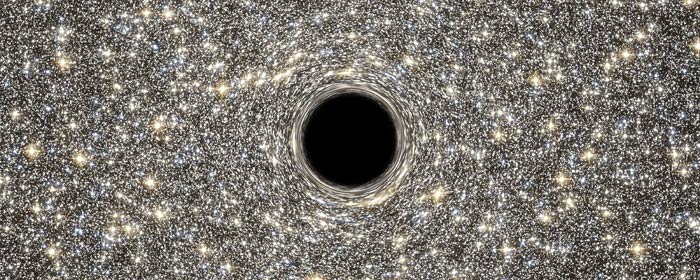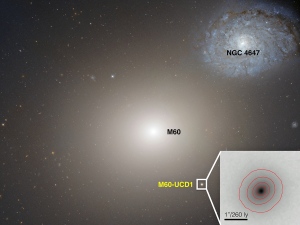Inspirational
Astronomers Have Discovered the Smallest Known Galaxy to Have a ‘Supermassive’ Black Hole

Researchers with NASA/ESA have found a supermassive black hole with the mass of 20 million suns lurking at the heart of Ultracompact Dwarf Galaxy (UDC) M60-UDC1. Located roughly 50 million light years away from Earth, M60-UDC1 is only 1/500th of the size of the Milky Way (with a diameter of 300 million light years), but contains some 140 million stars. According to Hubble’s press release, if you resided on a planet in this galaxy, you would be able to see the light of over 1 million stars at night with the naked eye, compared to the 4000 or so that are visible here on Earth.
While it might be jaw dropping to spend a night stargazing somewhere in M60-UDC1, the immense pressure generated from the supermassive black hole at the center of the galaxy might make you feel a bit… uncomfortable. This black hole accounts for a whopping 15% of the galaxy’s total mass, compared to the .01% of total mass that the Milky Way’s black hole comprises. The newly discovered supermassive black hole weighs five times as much as the black hole at the center of the Milky Way, which, according to lead author Anil Seth of the University of Utah “is pretty amazing given that the Milky Way is 500 times larger and more than 1000 times heavier than M60-UDC1.”
In the past, astronomers like study co-author Steffen Mieske have theorized that UDCs have supermassive black holes at their center because they appear “too heavy for the luminosity of their stars,” but these findings, reported this week in Nature, provide the first evidence in support of the theory.
Scientists detected the presence of the black hole and made calculations about its mass by observing the movement of the stars in M60-UDC1 from the Hubble telescope and the Gemini north telescope in Hawaii. The Hubble provided information about the size and density of the galaxy while the Gemini measured how much the black hole’s gravitational pull affected the movement of the stars.
This discovery is intriguing because it implies that there may be a significant number of black holes that have yet to be uncovered in our known universe. Many other UCDs may also have super massive black holes at their centers, meaning that there could be several more of these monsters than originally thought. Based off of these findings, “the astronomers predict there may be as many as double the known number of black holes in the local universe.”

These results also provide a new theory for how UCDs form, namely that ‘dwarf galaxies may actually be the stripped remnants of larger galaxies that were torn apart during collisions with other galaxies, rather than small islands of stars born in isolation.’ In the the past, M60-UDC1 might have passed too close to its much larger neighboring galaxy, Messier 60, leaving behind only pieces of the compact inner galaxy. It seems plausible that a black hole of this size would not develop from within such a small galaxy, but that it was once part of a larger galaxy that was torn apart. “We don’t know of any other way you could make a black hole so big in an object this small” says Seth.
Image Credits: Hubble / ESA
Typos, corrections and/or news tips? Email us at Contact@TheMindUnleashed.com
